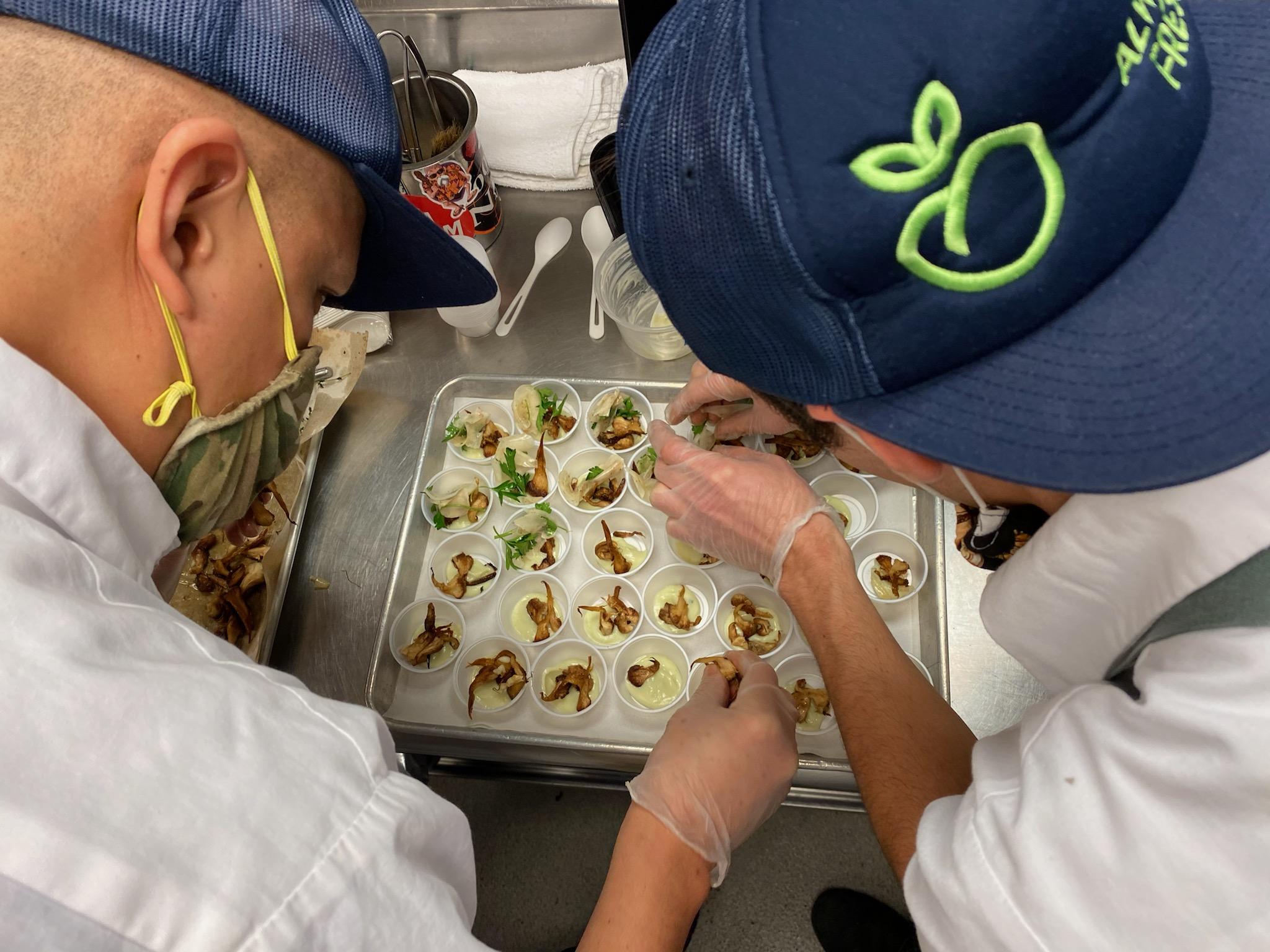Come Learn With Us! Why should you attend Education?
Our community needs Heroes! This is our chance to enhance our teams knowledge on our products and bring our team together to share our love for food and product knowledge! Explore produce, spices, herbs, wellness secrets and more in our staff education classes! Eat, Drink, Laugh, and Learn your way to being a true Healthy Living Hero!
Empower Ourselves, Empower our Staff, Empower our Community! Who ever said learning can't be fun?
Staff Education was built for YOU! Use this time to learn more about our products and your coworkers to develop a community within our stores. Want to know more about a new dish? Ask a Chef! Want to know more about local vegetables? Ask your produce supervisor! We want to empower you to be comfortable to ask the right questions, as much as we want to empower you to have the right answers!
Essential Behaviors of Healthy Living
This post might Sting! Ever hear about Thistles?
 The Artichoke…
The Artichoke…
Ever wonder why the word “Choke” is in an artichoke? Well, besides the small spines that line the purple and green leaves of this wonderful bud, and the cough worthy bitterness, it may be the hairy center above the “heart” is actually indigestible and can cause choking!
Well then? What does this power packed vegetable have to offer? Low in fat, high in fiber, vitamins and minerals; Artichokes have been known to help with weight loss for a very long time. They are tender when cooked well and quite delicious. Pair with Mediterranean flavors… think garlic, lemon, oregano!
The best part is that you can find Artichokes in our Cafe’s latest ATO (Assemble to order) Salads!
Follow along here:
“Artichaut” White Bean Salad with Spring Radish, Roasted Artichokes and French Lemon Vinaigrette
Welcome to the World of Beets #BeetsbyCafe 
 This week’s focus is on a root vegetable most of you are likely familiar with… BEETS!
This week’s focus is on a root vegetable most of you are likely familiar with… BEETS!
The origin of the beetroot goes way, way back before written history… crazy, right? Known to have been grown in the gardens of Babylon, in Ancient Greece and Rome, Northern Africa, and across Europe, beets were originally cultivated for their edible green leaves, similar in flavor to chard. Surprisingly they were also cultivated for their medicinal properties. Ancient Romans revered beets for their supposed aphrodisiac qualities, and Greek goddess Aphrodite would eat beets to enhance her appeal.
Nowadays it’s the bulbous root that takes center stage. The modern, round red root vegetable we’re familiar with developed from a carrot-shaped variety in the 16th and 17th centuries, when it became a staple in Eastern European cuisine in dishes such as borscht. Its popularity further spread worldwide after French chefs realized their potential in the 18th century. It seems like the whole world has grown to be enamored with beets (except for the Obamas, who asked to not have them planted in their White House vegetable garden… a good example of their polarizing earthiness!)
The beet season in North America runs from June to October, though they can be easily found year-round in most markets. Beets are known to have an earthy and mineral flavor profile, which turns to a natural sweetness when cooked. Due to this natural sweetness, beets can also be used to extract sugar from, in a process designed by German chemist Andreas Sigismund Marggraf back in 1747. Beet sugar production requires 4 times less water than sugar cane production, making it a more sustainable option as well as more accessible in more arid countries.
Not only are beets a great source of vitamins A, B, and C, they are a good source of calcium, iron, magnesium, potassium, manganese and fiber. Betaine, an important nutrient made from the B-complex vitamin choline, is the pigment that gives beetroot its deep rich color. Betaines also have powerful anti-oxidants and inflammatory properties- studies have shown beets can lower inflammation and pain in patients with ailments like osteoporosis and arthritis. Also containing amino-acid tryptophan, beets can be a powerhouse when it comes to boosting your mood. Beets are also extremely high in nitrates; when nitrates are converted by our bodies into nitric oxide, which helps to relax and dilate our blood vessels, our blood flow improves and blood pressure lowers. Thank you nature!
While the red beet is most common, there are several varieties with different flavor and color profiles, eaten both raw and cooked. Chioggia beets are those candy-cane striped beauties you may have cut into, while golden beets have a golden yellow hue. Today we will be cooking with red and golden beets!
This week’s recipes are courtesy of Mike Daley, our new Café chef: Pickled Beets and Mustard Seeds in a Roasted Beet Vinaigrette!
Pickled Golden Beets
2 cups gold beets, peeled and small diced
2 cups apple cider vinegar
1 cup sugar
1 cup water
Place the cut beets in a small plastic container. Combine the water, sugar and vinegar and bring to a boil. Pour the hot liquid over the beets. Cover and let cool in the liquid.
Pickled Mustard Seeds
1/2 cup mixed mustard seeds
1/2 cup white balsamic vinegar
1/4 cup sugar
Combine everything in a pot, bring to a boil, reduce to simmer, let cook 15 min. Pour into a plastic container and let cool.
Roasted Beet Vinaigrette
1 cup roasted red beets
1 cup red wine vinegar
2 cup canola oil
Kosher salt
Combine the beets and vinegar in a blender cup. Blend on high for 1 minute. Slowly begin adding the canola oil in a gentle stream until fully emulsified. Season with salt.
Top pickled beets and mustard seeds with vinaigrette and enjoy!
What's a Brassica you ask?!?!?! 
 Eating with the seasons has long been a way of life in many cultures. It’s easy to find non-seasonal produce year-round, with the number of large chain supermarkets across the US, but eating in-season is much more beneficial. Not only does seasonal produce taste better, but it also supports local farmers, and is richer in nutrients and overall health benefits.
Eating with the seasons has long been a way of life in many cultures. It’s easy to find non-seasonal produce year-round, with the number of large chain supermarkets across the US, but eating in-season is much more beneficial. Not only does seasonal produce taste better, but it also supports local farmers, and is richer in nutrients and overall health benefits.
Friday’s demo was a lesson on a vegetable group known for year-round availability. Some food groups grow all year, yet seasonality still has an effect on the flavor and freshness- Brassicas are one of these. Brassicas, the most diverse genus of vegetables, are a part of the mustard family Brassicaceae (formerly known as the cruciferous family Cruciferae). Powerhouses of the vegetable kingdom, brassicas are among the most commonly cultivated and nutritious vegetables in the world. Full of vitamin C, vitamin K, beta-carotene, and glucosinolates, brassica vegetables are also a great source of soluble fiber. The intake of brassicas has also been long associated with a decreased risk for developing cardiovascular diseases and different types of cancer, particularly in the digestive tract, liver, lung, and breast. Broccoli, cauliflower, collard greens, and cabbage are only a few members of this amazing family.
As far as taste goes, brassicas are highly versatile and can be prepared in a number of ways. While cooking tends to mellow out the bitterness, the range of colors and textures lend themselves well to be eaten raw. You might have had an aversion to brussels sprouts as a kid… this is because Brassica vegetables are full of compounds isothiocyanates, thiocyanates, and nitrites, which give them their characteristic pungent aroma and bitter taste. As the sun comes out and the temperature warms up, fresh spring vegetable salads are a great way to include some more brassicas in your diet!
The new spring ATO salad features three common members of the Brassica family: Cauliflower, broccoli, and broccoli rabe.
Cauliflower
Cauliflower is best known for its edible white head—which can be seared in thick-cut steaks, caramelized in the oven, or pureed into savory, creamy soups—but its core stems and leaves cook up nicely over high heat, too, drawing out a sweetness reminiscent of a cooked turnip. Quick-boiled cauliflower rice has recently become a favorite low-carb staple to use in place of high-carb grains like rice and pasta.
Broccoli
Broccoli is an edible bright green or purple plant with a flowering head, sturdy stalk, and nutrient-dense leaves. Broccoli can be eaten in its entirety and prepared in a myriad of ways: raw, roasted, steamed, sautéed, and even battered and fried. Enjoy it chopped up in a salad, steamed for a quick snack, puréed into a pasta sauce, roasted and served over lentils, rice, quinoa, or other grains with a drizzle of olive oil.
Broccoli Rabe
Broccoli Rabe, contrary to what you might think, is not broccoli- it’s actually more closely related to a turnip! Though its sharp bitterness can be polarizing, it is an asset in rich and heavy dishes as the bitterness lends itself well to cut through fats and proteins. Many typical Italian dishes utilize it (ever had pasta with sausage and broccoli rabe?)
Check out the recipe for Brassica Salad on our recipe rack!
Ganoush and Fattoush! Celebrating the Middle-East! 
This week’s culinary adventure takes us to the Middle East through the use of Eggplants and Cubanelle Peppers
Ever get bored of hummus?
Next time you’re craving a creamy dip for your pita, why not try baba ghanoush instead? Baba Ghanoush is a creamy eggplant dish believed to have originated in Levant and Lebanese cuisine, meaning “pampered papa” in Arabic. While native to the Middle East, its popularity has spread worldwide (Brazil, India, Mediterranean countries, and the US to name a few.) It holds particular popularity in India, where the eggplant originates from.
And if you need a way to use up all that leftover pita, Fattoush is another Middle Eastern staple to try your hand at! Said to have originated in Northern Lebanon, Fattoush is a bread salad, typically made with leftover pita and whatever vegetable scraps Lebanese farmers had on hand, such as cucumbers, tomatoes, purslane leaves (or lettuce), radish, green onions, and fresh herbs like parsley and mint. A simple vinaigrette and sumac spice at the end give Fattoush its distinctly complex flavor.
Here’s our Café’s own take on Baba Ghanoush and Fattoush!
Baba Ghanoush
Italian Eggplant: 4 medium sized
Garlic: 1 clove
Olive oil: 1 oz/ 2 tbsp
Juice of 1 lemon
Tahini: 1.5 oz/ 3 tbsp
Yogurt: 4 oz/ ¼ cup
Pomegranate Molasses: 0.5 oz/ 1 tbsp
DIRECTIONS
Char the eggplant on all sides heavily until the skin begins to separate; the flesh should be extremely soft. Peel the burnt skin, do your best to remove seeds. Combine flesh with the rest of ingredients and blend until smooth. Enjoy drizzled with olive oil and spices with warm pita!
Fattoush
Jalapeno: 3 charred, deseeded, and peeled
Cubanelle Peppers: 2 charred, deseeded, and peeled
Radishes: 6 sliced
English cucumber: ½ sliced
Mint: ¼ cup picked
Oregano: 1 oz/ 2 tbsp
Olive Oil: 4 oz/ ¼ cup
Lemon juice: 4 oz/ ¼ cup
Sumac: 1 tsp
Dill: 1 oz/ 2 tbsp, picked
Parsley: 1 oz/ 2 tbsp
Skin of 2 preserved lemons, sliced thin
Pita bread: one package
DIRECTIONS
Char peppers until the skin blisters. Deseed, peel, and slice thinly. Tear up pita bread and toss in olive oil, then bake at 400 degrees until crispy. While warm, add the pita and the rest of the ingredients into a bowl. Toss until coated and serve it warm!
Drink to Your Health! 
This week’s education session, led by our wellness buyer Hillary Lindsey, was focused on three immune-boosting and stress-relieving herbs. While we’ve reached the end of winter and the pandemic seems to be turning a corner, we could still use the power of natural and medicinal herbs to bolster our health and make sure we’re in good spirits to enjoy the coming summer!
ASHWAGANDHA
Ashwagandha (Withania somnifera) is a root that has been used in Ayurvedic medicine for thousands of years. You’ve probably seen the name in trendy wellness drinks or supplements, as it has become widely-acclaimed for its numerous health and wellness benefits. Studies have shown it to be extremely effective adaptogen for stress management. It works by lowering cortisol levels in the body, which in turn leads to stress reduction- something we could all benefit from during these trying times. Ashwagandha also supports healthy immune, neurological, endocrine, and reproductive systems. Is there anything this powerful plant can’t do?!
Ashwagandha roughly translates to “the smell and strength of a horse” in Sanskrit, the ancient language of Ayurvedic tradition. Due to its antibacterial properties, it was also traditionally used in Africa and Native America to treat infections.
Ashwagandha can be consumed in supplement, powder or tea form. For tea, steep 4-6 minutes.
CHAGA
Chaga (Inonotus obliquus) is a mushroom long used in traditional and folk medicine, notably in Russia, with the name originating from the Russian word for “fungus.” Chaga is known by many names internationally- it’s called kreftkjuke in Norway, translating to “cancer fungus.” This is because Chaga has numerous health benefits, including preventing or slowing the progression of cancer. Chaga contains incredibly high amounts of the pigment and potent antioxidant Melanin- some say that in addition to the natural amounts of melanin found in our skin, the melanin in Chaga can further aid in protection again sun damage in skin. Other benefits include supporting a healthy immune response, digestion, blood sugar, and liver function (vit. D, iron, magnesium.)
The conk (woody growth) is mainly found on birch trees and grows throughout the Northeast. It has an orange interior, and a charred-appearing exterior due to the high levels of melanin.
Chaga is best consumed in pill, powder, or tea form. For a delicious brew, steep 10-30 minutes for tea, and up to 3 hours for hot water extraction.
ROSEHIPS
Rosehips (Rosa canina) are red, round and berry-like in appearance, and are the fruit of the rose plant harvested in early Autumn. Most of us know of the importance of Vitamin C in our diets, consuming it in the form of oranges, or in those little vitamin powder packets. Most don’t know, however, that rose hips contain 60 times the amount of vitamin C in an orange, and that two tablespoons of rose hips equates to 76% of your daily recommended intake of vitamin C- crazy! High levels of vitamin C, antioxidants, and quercetin present in rosehips help to boost the immune system and oil production of the skin, stimulate collagen production and moisture content, and help protect again sun damage while healing impurities.
Rosehips have a naturally tart flavor. For tea, steep 10-15 minutes. Try sweetening the tea with a local honey for even greater health benefits!
Green Power Powders! 
 Matcha 抹茶
Matcha 抹茶
Matcha tea has been consumed in both Japan and China for centuries and has been a ceremonial drink within Zen Buddhism and across Japanese culture. Specific blends are created by grand tea masters and become known as konomi.
There are 3 grades of matcha: ceremonial, premium, and culinary
Matcha is made from ground green tea leaves, traditionally stone-ground, that have been shade-grown for 3-4 weeks, a process that increases the level of both caffeine and theanine (an amino acid that promotes the production of serotonin, dopamine, GABA, and glycine in the brain and provides an umani flavor).
The powder is blended into water or milk traditionally with a bamboo whisk, called a chasen.
Spirulina A. Platensis
Spirulina is a dried biomass of a blue-green algae that is believed to be one of the oldest life forms on planet Earth.
This algae was first used as a food source by the Aztecs and Mesoamericans, primarily from Lake Texcoco in Mexico and was called tecuitlatl.
Being high in protein, it was used by the Aztecs to enhance endurance and maintain stamina during marathon runs. This plant-based protein, phycocyanin, also antioxidant and anti-inflammatory properties.
Spirulina is also an excellent source of B1, B2, B3, Magnesium, Copper, Iron, and much more!
The sustainability and nutrient levels of spirulina have put this algae at the forefront of discussions on addressing food security and malnutrition for both humans and animals.
Moringa (M. oleifera)
Moringa is a tree native to India, also known as drumstick tree due to the long and slender seed pods.
The leaves, seed pods, bark, flowers, sap, and roots are all used in traditional herbal medicine in India. Moringa leaves in particular are high in Protein, Vitamin A, B2, B6, C, Iron, Calcium, and Magnesium.
Dried leaves are ground into a powder and also added to capsules as a dietary supplement. With its elevated levels of antioxidants, including quercetin and chlorogenic acid, the leaf extract can be used as a natural preservative to prevent oxidation in food and has been shown to protect against arsenic toxicity. The leaves have also been used to treat malnutrition. The seeds have even been used as a nontoxic way to filter water in both Asia and Africa.
supplement. With its elevated levels of antioxidants, including quercetin and chlorogenic acid, the leaf extract can be used as a natural preservative to prevent oxidation in food and has been shown to protect against arsenic toxicity. The leaves have also been used to treat malnutrition. The seeds have even been used as a nontoxic way to filter water in both Asia and Africa.
Initial studies have shown the use of moringa to support healthy blood sugar and cholesterol levels.
What do you know about Green Papaya? 
 Papaya Salad- “Som Tum”
Papaya Salad- “Som Tum”- Fill a small pot with Canola oil and bring up to 400F. Put in shrimp shells from cleaning shrimp and fry deeply until crispy all the way through. Strain and let cool fully before moving on.
- Place the Fried Shrimp Shells in a robot coupe and turn on until a powder forms. Add the rest of your ingredients and blend into a chunky paste. Cool and reserve.
- Carefully toss together all of your ingredients. Check seasoning with salt and lime juice!
- Serve and Enjoy!

On bread...to yeast, or not to naturally yeast 

A history of bread…




